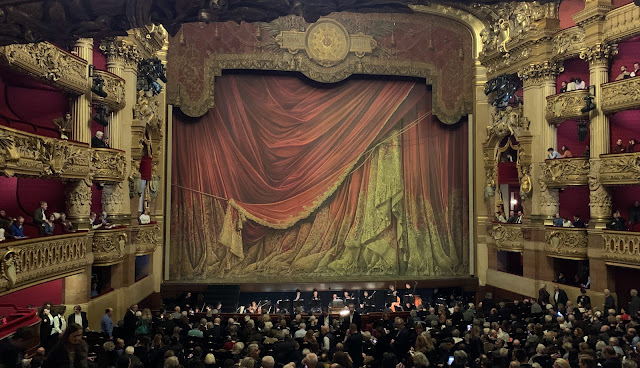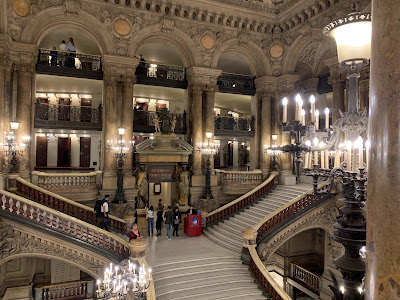French Stagecraft
The last few weeks have been busy with work deadlines, guests, parties, and travel, but we have also managed to squeeze in two operas and a play. Glenn and I saw La Traviata at the Bastille and Guilio Cesare at the Garnier, and we went with Esther and Abhijit to see Rohtko at Odeon's Atelier Berthier. All three productions had a few things in common: I was not bowled over by any of them, they all exhibited interesting and inventive stagecraft, and they all clocked in at 4+ hours.
La Traviata was placed into a modern-day setting, where the main character, Violetta, was something like an Instagram influencer who was constantly in touch with her friends through texts. The interesting stagecraft came with a set centered on two very large, moveable objects, which could act as interior walls of a house, the exterior wall of a club with a long line of patrons waiting to enter, or large video screens, depending on their orientation and the other objects on stage. When they were video screens, they sometimes showed super close-ups of the singers/actors (not live), photographs of texture to make the set pieces look like some specific part of a building, or the main character's Instagram posts and text conversations. The projected video and still photographic elements gave the director enormous flexibility, and it was used very effectively, I thought. Adding the text conversations, for instance, did not seem distracting at all but rather helped add nuance to the characters and sometimes added comic elements. The actor playing Violetta, Nadine Sierra, was spectacular. Here is a short video from her performance:
https://www.youtube.com/watch?v=J8Led8XyyRs
I was a bit underwhelmed by some of the other actors, and the opera was (in my too-old-to-be-out-late opinion) just too long. It was wonderful that Verdi could write four hours of such beautiful music, but really three hours, accomplished with a bit more aggressive editing, would have been fine.
Last week we invited Esther and Abhijit to join us to see the play Rohtko. It was based on a true story of a Chinese-immigrant-turned-math-teacher-turned-restaurant-owner-turned-art-forger in Queens New York, and how he fooled gallery owners, critics, patrons, and the whole art world for some time with a "found" work of Rothko's that he had actually forged. The play would be in Latvian, English, and Cantonese, with English and French surtitles. It sounded like an interesting story with many elements that would be right up my alley. And, at the same time, there is a very highly-touted Rothko retrospective playing at the Fondation Louis Vuitton, which would make a nice tie-in. In short, my expectations were high.
The first red flag came when I looked up the running time so that we could plan dinner, drinks, etc., to go along with our outing. It was four hours. A little unusual, I thought, for a theater performance, but maybe there's a lot of complicated plot elements that need to be covered, so ok. Then, the second red flag came in a conversation with Esther the day before. She mentioned that she had read two reviews of the play, one very positive and one very negative. That very large difference of professional opinion suggested, perhaps, something other than a standard theater production. Again, maybe ok--I have enjoyed a number of experimental and avant garde productions. And then, I did not notice the final red flag as we were entering the theater. I had all four tickets on my phone and was busy getting them scanned in, so I did not see the man standing at the entrance with a basket giving something to the theater audience as they entered. It turns out they were ear plugs.
Let me just say that the revealing of intricate plot elements was not a contributing factor in the running time. Playing very loud, atonal music for extended periods of time while the actors silently moved around the stage was a contributing factor. So, too, was abstract and unstructured musing on truth, beauty, authenticity, and time.
The set design, stage direction, and general staging, though, were fascinating, impressive, and effective. Much of the "action" (such as it was) took place in a Chinese restaurant. There were two moveable halves of the restaurant, and sometimes they would be turned so that we would see the exterior, peeking through windows to see what what going on inside. Other times they would be oriented so that the interior was on full display. Other times still, they were arranged as two separate restaurants--almost mirror images of each other--where the action was set in different time periods. All very clever, but that was not all. The actors playing the main characters often had cameras trained on them, and we were shown live close-ups on large screens above the stage. So audience members could watch the interactions between characters unfolding on stage and glance at a close-up to see the subtle facial expressions of the participants. Sometimes there were two separate restaurants and two separate screens, and I wasn't sure how they managed to sync the action up. And sometimes it was intentionally not synced, with one of the camera feeds lagging several seconds behind the other.
The necessary planning and technical expertise boggled the mind. How did they issue stage directions to the actors who were simultaneously playing to the audience and to a close-up camera? How did they place the camera operators so as to not interfere with the movements of the actors? How did they manage switching between camera feeds, and choosing some to show live and others to delay?
At the intermission, the four of us reconvened. We all agreed that there were elements we enjoyed and elements we found annoying. I was, perhaps, the most negative, but all decided that we had seen enough of the play to understand what it was trying to convey. So we left and found a nearby bar to have a drink or two and talk further about the play. Our conversation flowed freely from theater to life in Paris to art and beyond. We had a lovely, leisurely time and toasted Glenn's birthday again (which had been the previous day). We settled the tab and gathered our things to head home. As we were leaving, Glenn glanced at his watch and said, "Hey, we can actually catch the last hour of the play." We decided against it.
Finally, Glenn and I saw Guilio Cesare at the Opera Garnier on Valentine's Day. As an aside, I should say that attending an opera at Garnier is an iconic Paris experience, which I always enjoy regardless of whether I like the opera. The building is so over-the-top, with marble floors and staircases, sculpture, mosaics, painted panels, and so many other decorative flourishes, your eyes do not know where to rest. It is far from my preferred style of architecture, and nothing like it would ever be built today, but, in a way, perhaps the fact that the building is such an historical oddity makes it more special. And it's nice to dress up on occasion. The photo at the top of the post is a view from our excellent seats. I include a few more photos below.
The opera was set in Ancient Egypt, when Julius Caesar, fresh from some military triumph, visits Egypt and falls in love with Cleopatra. But this production had sort of a play-within-a-play structure set in the modern-day storage room of a Cairo museum. And the characters in the opera were statues and paintings in the storage room come to life. At one point, a cabinet displaying several busts was wheeled out and the busts started singing, Greek chorus style.
The stage had an appealing industrial aesthetic (as a storage room would have) with things being wheeled around by dolly and museum employees moving rolling staircases to access artifacts on high shelves.
The device was an interesting one, but, in the end, I thought its potential to comment on the relationship between history and modernity or its ability to establish useful metaphors (or do many things that I haven't even thought of) was never exploited. Instead, it felt like a stunt to no particular purpose.
And I thought that some attempts at humor, such as the moments when the cast "walked like an Egyptian," fell flat.
Cleopatra was wonderful, but the rest of the cast seemed unable to match her vocal power. Julius Caesar was played by a woman, which seemed like a reasonable choice, but, again, she was not an equal to Cleopatra on stage, even with comically large Roman-style military garb.
Even with some less-than-stellar productions, I am so happy to be able to experience all of these cultural events. Taking the good--the venues, the stagecraft, and the experimentation--with the bad is all part of the experience.






Comments
Post a Comment